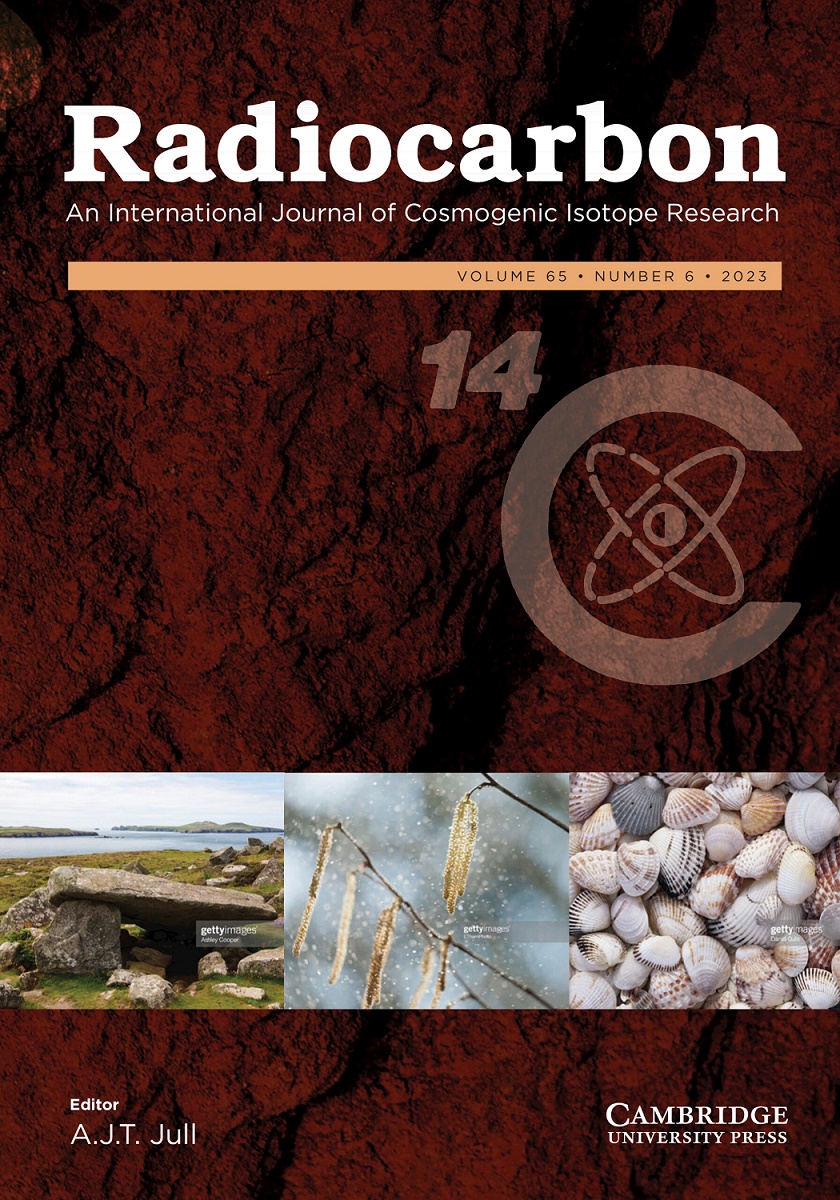中纬度树木年轮纤维素中碳的来源和年龄
IF 1.3
3区 地球科学
Q2 GEOCHEMISTRY & GEOPHYSICS
引用次数: 0
摘要
树木年轮的纤维素通常被认为主要是由光合作用直接同化二氧化碳形成的,因此可用于以年度分辨率重建过去大气中的 14C 浓度。然而,除了树木年轮中的直接同化作用外,人们对前几年储存的碳的范围和年龄知之甚少。在这里,我们研究了四种不同树种(橡树、松树、落叶松和云杉)早材和晚材纤维素中的 14C,这些树种通常用于放射性碳校准和测年。在放射性碳弹高峰期(1958-1972 年),这些树木仍在生长。我们将树环分段中测得的纤维素 14C 与树环形成时间对应的大气 14C 进行了比较。我们观察到,只有在橡树的早材中,纤维素 14C 含有前 1-2 年大气 14C 信号的 50%,而在针叶树的早材中,纤维素 14C 含有大气 14C 信号的 20%,在云杉的晚材中也是如此。考虑到早材的质量贡献率较低,而且大气 14C 在几年内的变化通常小于 3‰,使用生长在温带海洋性气候中的树木的完整环来估算大气 14C 浓度的偏差可能微乎其微。本文章由计算机程序翻译,如有差异,请以英文原文为准。
ORIGIN AND AGE OF CARBON IN THE CELLULOSE OF MID-LATITUDE TREE RINGS
Cellulose of tree rings is often assumed to be predominantly formed by direct assimilation of CO2 by photosynthesis and consequently can be used to reconstruct past atmospheric 14 C concentrations at annual resolution. Yet little is known about the extent and the age of stored carbon from previous years used in addition to the direct assimilation in tree rings. Here, we studied 14 C in earlywood and latewood cellulose of four different species (oak, pine, larch and spruce), which are commonly used for radiocarbon calibration and dating. These trees were still growing during the radiocarbon bomb peak period (1958–1972). We compared cellulose 14 C measured in tree-ring subdivisions with the atmospheric 14 C corresponding to the time of ring formation. We observed that cellulose 14 C carried up to about 50% of the atmospheric 14 C signal from the previous 1–2 years only in the earlywood of oak, whereas in conifers it was up to 20% in the earlywood and in the case of spruce also in the latewood. The bias in using the full ring of trees growing in a temperate oceanic climate to estimate atmospheric 14 C concentration might be minimal considering that earlywood has a low mass contribution and that the variability in atmospheric 14 C over a few years is usually less than 3‰.
求助全文
通过发布文献求助,成功后即可免费获取论文全文。
去求助
来源期刊

Radiocarbon
地学-地球化学与地球物理
CiteScore
16.20
自引率
6.00%
发文量
85
审稿时长
6-12 weeks
期刊介绍:
Radiocarbon serves as the leading international journal for technical and interpretive articles, date lists, and advancements in 14C and other radioisotopes relevant to archaeological, geophysical, oceanographic, and related dating methods. Established in 1959, it has published numerous seminal works and hosts the triennial International Radiocarbon Conference proceedings. The journal also features occasional special issues. Submissions encompass regular articles such as research reports, technical descriptions, and date lists, along with comments, letters to the editor, book reviews, and laboratory lists.
 求助内容:
求助内容: 应助结果提醒方式:
应助结果提醒方式:


